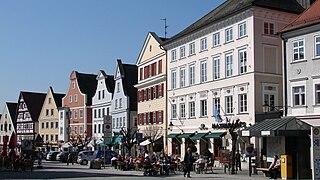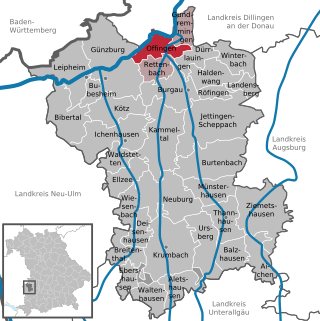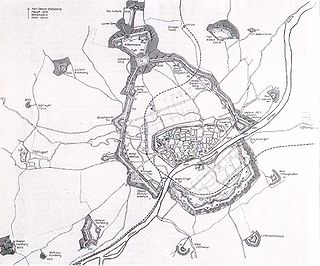
Ulm is a city in the German state of Baden-Württemberg, situated on the river Danube on the border with Bavaria. The city, which has an estimated population of more than 126,000 (2018), forms an urban district of its own and is the administrative seat of the Alb-Donau district.
Günzburg is a Landkreis (district) in Swabia, Bavaria, Germany. Its capital is the town Günzburg. It is bounded by the districts of Dillingen, Augsburg, Unterallgäu and Neu-Ulm, and by the state of Baden-Württemberg.
Neu-Ulm is a Landkreis (district) in Swabia, Bavaria, Germany. It is bounded by the districts of Günzburg and Unterallgäu and the state of Baden-Württemberg.

Memmingen is a town in Swabia, Bavaria, Germany. It is the economic, educational and administrative centre of the Danube-Iller region. To the west the town is flanked by the Iller, the river that marks the Baden-Württemberg border. To the north, east and south the town is surrounded by the district of Unterallgäu.

Günzburg is a town in Bavaria, Germany. It is a Große Kreisstadt and the capital of the Swabian district Günzburg. This district was constituted in 1972 by combining the city of Günzburg – which had not previously been assigned to a Kreis (district) – with the district of Günzburg and the district of Krumbach.

Elchingen is a municipality about 7 km east of Ulm–Neu-Ulm in the district of Neu-Ulm in Bavaria, Germany.

Weißenhorn is a town in the district of Neu-Ulm in Bavaria. Weißenhorn is located about 22 km southeast of Ulm.

Vöhringen is a town in the district of Neu-Ulm in Bavaria, Germany. It is located on the Iller, approximately 18 km south of Ulm and 40 km north of Memmingen. It is in the Donau-Iller Region in Central Swabia.

The town of Senden is the second-largest town of the district of Neu-Ulm in Bavaria and is located at the border to Baden-Württemberg. The town belongs to the Donau-Iller-Nahverkehrsverbund. Senden's neighbours are Neu-Ulm in the north, Weißenhorn in the east, Vöhringen in the south and Illerkirchberg in the west.

Lauingen is a town in the district of Dillingen in Bavaria, Germany. It is located on the left bank of the Danube, 5 km west of Dillingen, and 37 km northeast of Ulm.

Leipheim is a town in the district of Günzburg, in Bavaria, Germany. It is situated on the Danube, 5 kilometres west of Günzburg, and 17 kilometres northeast of Ulm. The village Riedheim and the hamlet Weissingen are districts of Leipheim. Since 1993, Leipheim has been twinned with the Hungarian town Fonyód.

Offingen is a municipality in the Swabian administrative district Günzburg in Bavaria in Germany.

Ulm Hauptbahnhof is the main station in the city of Ulm, which lies on the Danube, on the border of the German states of Baden-Württemberg and Bavaria in the Danube-Iller region.

The 56th Artillery Command is a two-star command of the United States Army that serves as the Force Field Artillery Headquarters for U.S. Army Europe and Africa, with a mission to synchronize, integrate, and control fires and effects in support of the theater land component. The unit was originally formed on September 14, 1942, as the 56th Coast Artillery Brigade and has been reorganized and redesignated several times until its inactivation on June 30, 1991, following the reunification of Germany and the end of the Cold War.

The fortress of Ulm was one of five federal fortresses of the German Confederation around the cities of Ulm and Neu-Ulm. With its 9 km polygonal main circumvallation Ulm had the biggest fortress in Germany in the 19th century and it is still one of the biggest in Europe.

The 59th Ordnance Brigade is a military unit of the United States Army. The unit is currently stood up as the U.S. Army Ordnance School's training brigade. In its previous iteration, the brigade had more than 6,500 soldiers. It was responsible for storage, delivering, maintaining, Nuclear and Chemical Control Orders, and supervising the weapons of mass destruction for U.S. Forces and Forces of the Allied NATO-Countries, except France.

The 81st Field Artillery Regiment is a field artillery regiment of the United States Army.

The Pershing II Weapon System was a solid-fueled two-stage medium-range ballistic missile designed and built by Martin Marietta to replace the Pershing 1a Field Artillery Missile System as the United States Army's primary nuclear-capable theater-level weapon. The U.S. Army replaced the Pershing 1a with the Pershing II Weapon System in 1983, while the German Air Force retained Pershing 1a until all Pershings were eliminated in 1991. The U.S. Army Missile Command (MICOM) managed the development and improvements, while the Field Artillery Branch deployed the systems and developed tactical doctrine.

The 55th Support Battalion was a unit of the United States Army, which was last active from 9 July 1982 to 15 June 1991.
There are a number of Pershing missile models of the Pershing 1 and Pershing 1a Field Artillery Missile Systems and of the Pershing II Weapon System.






















